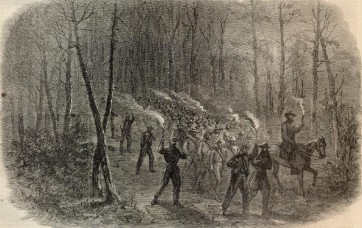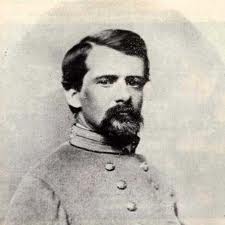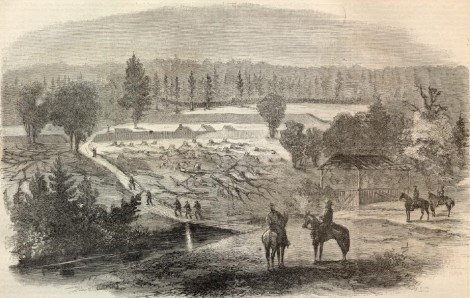
David Osborn Davis was born 13 Feb 1831 in Alton to Andrew Davis (1805 -1878) and Sarah Cate Davis (1804-1856). He was a shoemaker by trade and living in Durham when he married Martha A. Demeritt in 1854. He and Martha lost two children, Ada Augusta (born 16 Feb 1856; died 1 May 1858) and Clarence Fremont (born Nov 1856; died Mar 1857). They had two other children Augusta A. Davis (1858-1920) and Melvin Davis (1860-1948) before the start of the War.
 When the War broke out he resided in Durham and enlisted as a Private in Co. D, 2nd Infantry on 30 Apr 1861 for 3 months at age 30. He did not immediately muster in until 10 May 1861 when he was repaid for a 3 year enlistment. He was promoted on 1 Jun 1861 to a Corporal in Company D and mustered out 19 Sept 1862 near Fairfax Seminary, VA, due to disability. His medial record dated 19 Sep 1862 reads: physical description 5ft-6in tall, dark complexion, hazel eyes, dark hair. During the last 2 months, soldier has been unfit for duty 60 days “— chronic rheumatism: the right leg and side is very much affected, rendering him very lame and incapable of performing any active duty. He will never be able to resume military duty”.
When the War broke out he resided in Durham and enlisted as a Private in Co. D, 2nd Infantry on 30 Apr 1861 for 3 months at age 30. He did not immediately muster in until 10 May 1861 when he was repaid for a 3 year enlistment. He was promoted on 1 Jun 1861 to a Corporal in Company D and mustered out 19 Sept 1862 near Fairfax Seminary, VA, due to disability. His medial record dated 19 Sep 1862 reads: physical description 5ft-6in tall, dark complexion, hazel eyes, dark hair. During the last 2 months, soldier has been unfit for duty 60 days “— chronic rheumatism: the right leg and side is very much affected, rendering him very lame and incapable of performing any active duty. He will never be able to resume military duty”.
He returned home to Durham and not quite a year later on 14 Aug 1863 he was either drafted or re-enlisted (there two conflicting military records) into Company F, 5th Infantry as a private at the age of 33. He was wounded in action on 25 Mar 1865 at the Battle of Hatcher’s Run, when hit by a Minnie ball to the left upper arm. The amputation was performed on the field. Five days later he was admitted to Emory Hospital in Washington, D.C. “Cold water dressings applied to stump, stimulants internally. Mar 31, Continued Apr 8th, May 1st, May 17th —transferred to USA General hospital, Chester, PA 2 June 1865.” He received a disability discharge on4 Jul 1865 at Chester, PA., and transferred to Webster General Hospital in Manchester, NH.
Between his two tours of warfare, he and his wife had another child, Annabell (1863-1953). After he left the military they had two more daughters: Luetta (1866-1928) and Gertrude (1868-1939). By 1870 at the age of 39 he was employed as a mail carrier in Durham in 1870. The family increased by two sons during this time - Herbert (1874-1938) and Everett (1877-1928).
He and his family, moved to Newmarket in 1889 where he resided for 31 years prior to moving to his son’s home in Manchester in 1920 where he died on 21 Jan 1922. Mr. Davis would march in the annual Decoration Day parades with the G.A.R., and in 1891 the Newmarket Advertiser published a report of him marching in the Exeter parade at the dedication of that Town’s General Marston Monument. By 1910 he and his wife were living at 84 Exeter Street with their daughter, Gertrude David Morse and her daughters Alice and Dorothy
His Obituary reads:
David O Davis (age 90) for 31 years a resident of Newmarket, died at the home of his son in Manchester, NH where he had resided for the past few years. Mr. Davis was born in Alton, NH, Feb 13, 1831, but had resided in Durham and Newmarket the most of his life. For many years he carried the mail and was also employed by the American Express Company. He enlisted in the civil war in April 1861, in Co.D, 2nd NH vols and after 17 months service he was discharged for disability. Recovering from a serious attack of rheumatism he re-enlisted in the 5th NH Aug 14, 1863, and served until near the end of the war. Corporal Davis participated in over fifty engagements of the Civil War, losing his left arm at Hatcher’s Run, VA, a few days before the war ended. Mr. Davis was a charter member of Charles Sawyer Post, GAR of Dover.
Mr Davis married Martha A Demeritt of Durham, March 1, 1854. Mrs Davis died Oct 20, 1918, and her loss was a great blow to him. Six children survive him, Melvin of Manchester, Herbert of Pasadena, Cal, Everett of Freehold, NJ, Mrs. James Watson of Newmarket, Mrs. Anna B Hudson of Exeter, and Mrs Gertrude Morse of North Brookfield, Mass. He is also survived by two sisters, Mrs. Thomas Cheswell and Mrs. Jeanette Hale, both of Manchester. The funeral was held at the home of his son in Manchester, and the body was brought to Newmarket for interment in Riverside Cemetary. Rev. MH Wakefield read the committal service, and the GAR performed their burial service, taps being sounded by an American Legion Bugler. The American Legion was represented by a detachment, and members of that order acted as bearers.
 On February 5, Brig. Gen. David Gregg’s cavalry division rode out to the Boydton Plank Road via Ream’s Station and Dinwiddie Court House in an attempt to intercept Confederate supply trains. Maj. Gen. G.K. Warren crossed Hatcher’s Run and took up a blocking position on the Vaughan Road to prevent interference with Gregg’s operations.
On February 5, Brig. Gen. David Gregg’s cavalry division rode out to the Boydton Plank Road via Ream’s Station and Dinwiddie Court House in an attempt to intercept Confederate supply trains. Maj. Gen. G.K. Warren crossed Hatcher’s Run and took up a blocking position on the Vaughan Road to prevent interference with Gregg’s operations.
(REBELS on Hatcher’s Run, illustration published oin Harper’s magazine)
Two divisions of the II Corps under Maj. Gen. A.A. Humphreys shifted west to near Armstrong’s Mill to cover Warren’s right flank. Late in the day, Maj. Gen. John B. Gordon attempted to turn Humphreys right flank near the mill but was repulsed. During the night, the Federals were reinforced by two divisions.
On February 6, Gregg returned to Gravelly Run on the Vaughan Road from his unsuccessful raid and was attacked by elements of Brig. Gen. John Pegram’s Confederate division. Warren pushed forward a reconnaissance in the vicinity of Dabney’s Mill and was attacked by Pegram’s and Maj. Gen. William Mahone’s divisions. Pegram was killed in the action. Although the Union advance was topped, the Federals extended their siege works to the Vaughan Road crossing of Hatcher’s Run.
The Death of General John Pegram.
 During the battle on February 6 and somewhere near the sawdust pile, Confederate General John Pegram gave his life. The 33-year-old was “riding immediately with his troops” when shot through the body near his heart. John was a native son of Petersburg and the brother of the famed artillerist Colonel William “Willie” R.J. Pegram who also would be mortally wounded less than two months later on April 1 at nearby Five Forks. John had just married Hettie Cary the lovely “belle of Richmond” on January 19. The marriage was the talk of the Confederate capital as he was considered “one of the handsomest and most lovable men” ever to wed “the handsomest woman in the Southland – with her classic face, her pure complexion, her auburn hair, her perfect figure and carriage…” She was staying with her mother when his body arrived from the battlefield and she was told of the general’s demise. Kyd Douglas, its original bearer, sadly noted “a fiancée of three years, a bride of three weeks, now a widow!” Even this happy occasion and brief respite from the war weariness felt by Southern civilians came quickly to a fateful end at Hatcher’s Run.
During the battle on February 6 and somewhere near the sawdust pile, Confederate General John Pegram gave his life. The 33-year-old was “riding immediately with his troops” when shot through the body near his heart. John was a native son of Petersburg and the brother of the famed artillerist Colonel William “Willie” R.J. Pegram who also would be mortally wounded less than two months later on April 1 at nearby Five Forks. John had just married Hettie Cary the lovely “belle of Richmond” on January 19. The marriage was the talk of the Confederate capital as he was considered “one of the handsomest and most lovable men” ever to wed “the handsomest woman in the Southland – with her classic face, her pure complexion, her auburn hair, her perfect figure and carriage…” She was staying with her mother when his body arrived from the battlefield and she was told of the general’s demise. Kyd Douglas, its original bearer, sadly noted “a fiancée of three years, a bride of three weeks, now a widow!” Even this happy occasion and brief respite from the war weariness felt by Southern civilians came quickly to a fateful end at Hatcher’s Run.
(Image of Hatcher’s Run published Civil War Harper’s Weekly, November 14, 1864)
